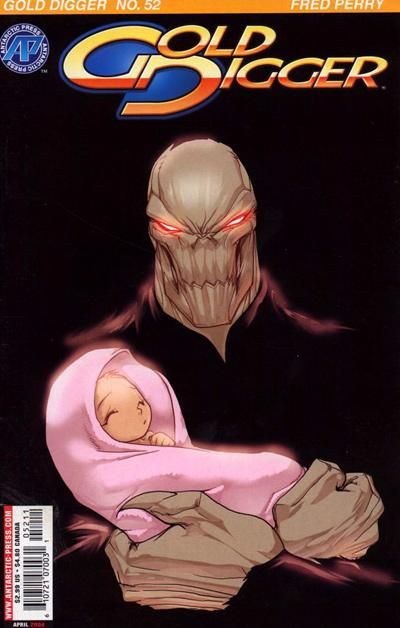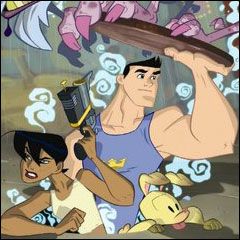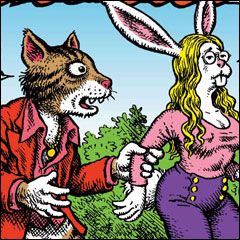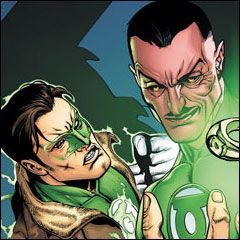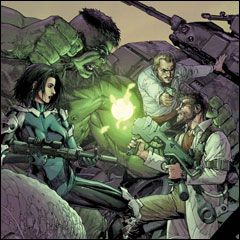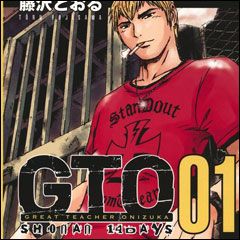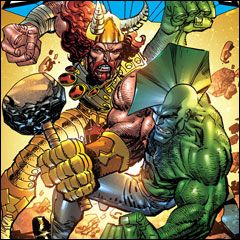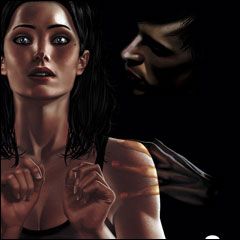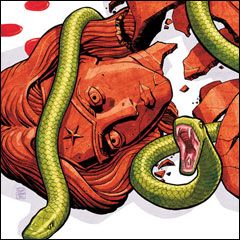Hello and welcome to What Are You Reading?, our weekly look at the comics, books and other things we've read this week. Today our special guest is Jason Green.
Jason Green is the editor of comics coverage for the St. Louis-based pop culture website PLAYBACK:stl, and a writer and editor for the comics collective Ink and Drink Comics, whose fourth release (a Western anthology titled Off the Wagon) will debut at this year’s C2E2.
To see what Jason and the Robot 6 crew have been reading, click below.
*****
Michael May
I checked out Ben Caldwell’s The Dare Detectives, Volume 1: The Snow Pea Plot this week and loved it as much as I hoped I would. I’m a big fan of Caldwell’s work, especially his Action Classics adaptations of literary adventure stories, so it’s a pleasure to see him have this much fun with his own creations. The titular heroes are a group of hapless detectives in a world where humans live, work, and commit crimes next to talking animals. Athletic Maria Dare leads the group and is the brains of the operation; charming, but dim-witted Toby provides the muscle; JoJo the rabbit mostly complains, but also contributes street smarts.
In The Snow Pea Plot, a fight with a monkey named Furious George leads to the group’s investigating the kidnapping of their landlord – a Chinatown restaurateur – and the theft of his snow peas. Without spoiling anything, the case leads them into conflict with mafia pandas, a sinister raven with a penchant for Poe-esque rhyming, a former showgirl turned supervillain, and her pet Yeti (plural). All of this is illustrated in Caldwell’s awesomely animated style and it’s wonderful.
I also read Susan Kim, Laurence Klavan, and Faith Erin Hicks’ Brain Camp, but was surprised to be disappointed by it. I’m a big fan of Kim and Klavan’s City of Spies and of Hicks’ work in general, but they’re not playing to each other’s strengths in this. Kim and Klavan have written a compelling horror story featuring a couple of characters I really liked. They also hit on powerful themes, like the importance to teenagers of being accepted by both peers and parents. And while Hicks brings those main characters to life and makes me like them even more, Kim and Klavan’s story feels darker than Hicks’ pictures. I would love a book by Hicks about young love at a normal summer camp, but I wasn’t able to immerse myself in the horror of what was going on in this one. Likewise, I would have loved this script depicted in a darker style.
On a lighter note, I finally checked out Roger Langridge’s Snarked #1. I liked the 0 issue, but it felt slight. It set up the characters and the playful tone of the series without giving me a good indication of what it was going to be about. That comes clear in #1 and I love it: the humor, the poems, the intrigue, the adventure, and the potential for redeeming a couple of ne’erdowells. Also, the Cheshire Cat’s my favorite Wonderland character and Langridge puts him to good use. Looking forward to catching up to the rest of the series so far.
Chris Mautner
This week I read The Life and Death of Fritz the Cat, a hardbound collection containing most (but not all) of Robert Crumb's seminal funny animal strips. I've read this material several times before in a variety of other collections, so it didn't hold many surprises. I'll be honest, I don't really think the Fritz material, as well known by casual fans as it is, thanks largely to the Ralph Bakshi movie, rates among Crumb's best material. There's good stuff here, don't get me wrong -- "Fritz Bugs Out" and "Fritz the No-Good" are still pretty funny and "Superstar," in which the ego-bloated fuzzy feline gets an icepick in the back of his head, remains a classic. But Crumb was able to achieve greater aesthetic highs by confronting his demons in a more direct, autobiographical fashion without the need for an anthropomorphic alter ego. Basically, he outgrew the character. Rather quickly too I might add.
All that said, I'd still recommend this book for the casual reader at least if it weren't for two glaring errors: a) only one page of the two-page "Fritz Comes On Strong" is in here, which, I think, kills the setup of the joke a bit; and b) pages 17 and 18 are printed out of order. Those two problems, combined with the my above rant, make the book tough for me to recommend to the Crumb neophyte.
Tom Bondurant
I would have liked Green Lantern #6 (written by Geoff Johns) if guest artist Mike Choi hadn't drawn Hal Jordan to look about 13 years old. Until Sinestro showed up, I thought seriously that the scenes of Hal and Carol on a date -- and, incidentally, referring to their hoppin' sex life -- were part of an extended flashback. (Not that they were having sex at 13, mind you, but that would have made Hal's depiction easier to reconcile.) And come to think of it, isn't Carol still a Star Sapphire? Wouldn't that make Hal's jaunts into space (voluntary and otherwise) easier to take? Regardless, I liked Sinestro's role in this story, and I like that Johns has gone back to using Carol as a proxy for Hal's Earthbound life. The combination subverts nicely the classic "Hal must choose between his two lives" subplot. Just draw Hal a little older next issue, okay?
Penciller Amy Reeder and inker Richard Friend take over the art on Batwoman #6 (still written by W. Haden Blackman and J.H. Williams III). Having been a fan of their Madame Xanadu work, I expected to like this issue despite the stylistic shift. Accordingly, I was pleasantly surprised at how little difference they made. The layouts are still involving and the figures are still expressive, although in different ways than Williams. It reminds me of the stretches where Paul Smith would sub for Steve Rude on Nexus -- the same basic look was maintained, just with a different set of tools. For my money, Reeder and Friend can stay as long as they want.
Finally, I tracked down 2009's Fin Fang 4 Return, wherein Scott Gray and Roger Langridge offer four stories about the Marvel U's favorite quartet of semi-domesticated monsters. As you might expect, it's all good. However, I particularly liked "Little Orphan Angry," in which Googam gets himself adopted by an Angelina Jolie-style celebrity activist. One word: lederhosen.
Carla Hoffman
So weirdly enough, I had some philosophical quandaries this week, as I read Incredible Hulk #5 and PunisherMAX #22 back to back and got whiplash. On one hand, you have this icepick of a Frank Castle tale coming to it's final conclusion, pondering the futility of one man's war on the sins of mankind, the emotional and psychological torture it would be to get up and do that for 30 years, how there is nothing in the end but death and memory left behind... and on the other hand, you have radioactive monkey poop. It's not really fair for me to compare them, both in tone and length of time Aaron's had to say his piece in both titles, but I cannot say that Jason Aaron is bringing it in the Incredible Hulk. As far as issue #5, I can go so far as to say that Whilce Portacio isn't bringing it either, as the art work feels rushed and whipped onto the page. I mean, Aaron's got a good thing going with the idea of madness and who had that trademark between the Hulk and Banner and the idea that SHIELD would have a squad specifically for taking down guys who dabble in mad science is pretty neat but there's something missing. These two issues do not feel like they came from the same dude.
I also picked up the trade paperback of the start of Paul Cornell's Action Comics with Superman: the Black Ring. I picked up a couple of these and it was a sort of runaway hit at the shop, so now was finally my chance to dive in from the beginning. Man, this is good. Lex Luthor is a neat character and pokes at my brain from time to time thanks to Michael Rosenbaum and Azzarello's Lex Luthor: Man of Steel, so I'm glad to say that Cornell's vision totally jibes with both of those kinds of approaches. Despite its roots in the Blackest Night color scheme, the story is quick and approachable for even new readers and the cameo from Death was a nice touch. It didn't seem to take the book anywhere it didn't want to go and using one of Sandman's greatest characters to flesh out one of the four-color-est super-villains of all time? Bravo, sir.
Brigid Alverson
I never read the original GTO manga series, which was well into the double digits by the time I started reading manga, but that hasn't stopped me from enjoying the first volume of the sequel, GTO: 14 Days in Shonan. Great Teacher Onizuka is one of those edgy, overly strong, but basically good-hearted guys that you run into a lot in seinen manga. He kicks off this book by saying something outrageous on television, so he decides to get out of town for a while and return to his childhood home of Shonan. Almost as soon as he steps off the train, he makes the acquaintance of a creepy girl and a beautiful woman. The woman, Shiratori, runs a foster home for abused and neglected children, and the creepy girl is one of her wards. Onizuka volunteers to help out at the home, partly but not entirely for noble reasons, and the interactions between the brash teacher and the troubled youths make for a great story. It's your basic crazy-teacher story, but it's a good one and a very entertaining read.
I'm struggling a bit with Soulless, Yen Press's adaptation of the first novel in Gail Carriger's Parasol Protectorate series. I think the story is a bit too compressed—there's a lot of background you need to know about vampire hives and such that isn't really spelled out. I'm picking it up as I go along, but it makes reading feel like work. On the other hand, it's a nice supernatural melodrama, definitely in a high emotional key. I'm a huge fan of the artist, rem, who won one of Kodansha's manga competitions for an earlier work; she has a very natural, dynamic style, and she's clearly having fun here; the main character's predilection for plunging necklines makes her look like a Victorian Power Girl.
Jason Green
One of my weirder quirks as a comics reader is I’m a big sampler: I’m willing to give a lot of new series or creative teams an issue or two tryout, but then I’m constantly trying to stay on top of all these new series so I don’t end up dropping money on, say, all 9 issues of Brian Azzarello’s Deathblow only to discover I really, really don’t like it. Not that I’m bitter or anything. The side effect of this is that a lot of books I’ve been following a long time tend to stack up because, well, “I know it’s good” and don’t need to keep on top of it as closely.
That’s really my only excuse as to how I fell a preposterous ten years behind on reading Fred Perry’s Gold Digger (Antarctic Press), a series I’ve been buying monthly since 1996. I’ve finally started chipping away at that backlog 3 issues at a time, and just recently polished off #50-52 of the color series from 2004. When people talk about long runs from creators, they mostly overlook the fact that Perry’s been a one-man show for 184 issues and is still going strong. These three issues were a showcase of what Perry does best: small character moments between the three Diggers sisters, huge magic battles captured with his trademark manga-esque flair, done-in-one stories that still manage to pay off subplots that have been building for years, and just enough exposition to catch up a new or lapsed reader without sounding wooden. It’s nice to know I’ve got 80+ more issues of the series just waiting for me to read them…if only there were enough hours in the day.
Another old favorite I had fallen behind on (but not as far behind, thank goodness) was Erik Larsen’s Savage Dragon (Image), for my money one of the most consistently great superhero titles going. I recently charged through #163-169, the six-part-plus-an-epilogue “Emperor Dragon” storyline that saw Malcolm Dragon (Dragon’s son, who we’ve watched grow up in real time over the last decade and a half) face off against his now super villain dad. Powerful stuff. Stories like this are why I like creator-owned comics: huge things happen in this storyline, and while Larsen hits a bit of a reset button, he still leaves the world of his comic entirely different than it was when the story started. A superhero comic with real change, not just the illusion of it? What a novel concept!
The only book with a spine I’ve cracked lately was Usumaru Furuya’s No Longer Human Vol. 1 (Vertical), part of the most recent Manga Moveable Feast. I missed the deadline for the Feast and still haven’t finalized my own formal review, but part of that is because I just thoroughly, thoroughly hated the book. It purports to be based on the diary of a young man who feels completely disconnected from humanity, but it’s actually based on a novel by decadent writer Osamu Dazai, and it revels in that decadence in an off-putting way. Furuya tries to show how disconnected the lead character is by having him have a series of casual, unfulfilling sexual encounters, but it comes off more as an excuse to have a nude scene in every chapter. I mean, I’m not a prude by any stretch, but when the lead has had two hookers fall in love with him in just the first 50 pages, that’s pretty much where I check out.
Other than that, well, I’ve got a 7-week-old daughter at home now, so single issue comics are about all I have time for of late, but I’ve managed to sneak quite a few in. In “sampling new series” mode, I was really impressed by the first issue of Whispers (Image), the new series from Joshua Luna. I loved the Luna Bros’ survival horror series Girls, and Whispers gets off to a similarly strong start. The high concept is that it’s about a boy who when he falls asleep, he becomes an astral projection that can influence the lives of people through their subconscious—it’s not quite mind control, more like a subliminal nudge. It’s a cool concept, and the art has a stunning stylized-realism vibe with a touch of Mike Allred. With how strong this art is, it’s surprising Joshua turned the art chores on all their previous collaborations to his brother as he’s an impressively talented artist in his own right.
I was similarly impressed with the first issue of Winter Soldier #1 (Marvel), which was just as consistently good as any Brubaker-penned Cap series. Art-wise, I don’t know what it is about Butch Guice, but I just can’t glom onto his artwork—the pages look good, but I frequently find them hard to follow. It makes me miss the Steve Epting days.
The first 3 issues of The Defenders (Marvel) were more of a mixed bag. Then again, I’ve had a mixed reaction to most of Matt Fraction’s Marvel output: I absolutely loved The Order, dug the hell out of Immortal Iron Fist, but have been far less impressed by pretty much everything else I’ve sampled. His writing on The Defenders has its strong points, most notably in the interplay between the characters, but I often wasn’t completely engaged by the plot, and his cliffhangers in particular never gave me the “Oh, man, I’ve gotta read the next issue!” feeling. The art from the Dodsons was stunning enough that I’ll probably stick around for a while…they certainly kept me around Uncanny X-Men for a good long while.
Perhaps unsurprisingly, a lot of the series I’ve been sampling have been in the New 52, which I’ve been staying pretty on top of to slowly whittle my list down from my initial 20 tryouts to my current 13. (I was reading exactly zero DCU titles before the relaunch, so clearly it worked on me.) This week, I read the latest Wonder Woman—possibly the strongest issue of the title yet (I looooved the new Poseidon), even though I can’t for the life of me understand what’s going on its last page—and caught up on the last 3 issues of Voodoo. It’s a real shame that Ron Marz was pushed off the title, because he was building a great “B-movie thriller” vibe that seemed completely missing from Josh Williamson’s first issue. The fact that Voodoo wasn’t a straightforward superhero title was one of its stronger points, but it feels like it’s being pushed in that more generic direction, which is a bummer. It’s still great watching Sami Basri grow as an artist: he still draws great cheesecake, but with every issue, his characters get less stiff and more expressive. I’ll be giving that one at least a few more issues.
One of the few titles I’ve stayed consistently caught up on is X-Factor—for my money, Marvel’s most consistently entertaining title. For all six years of its run, this book has stayed at the top of my reading stack, and other than a slight decline during Larry Stroman’s return to the series, it’s all been golden. A lot has been made lately of Marvel’s double-shipping various titles, something they’ve been doing on X-Factor for eons (18 issues of it shipped in 2011) and I don’t mind one bit…I’ll take every page of this title I can get. It’s gotten even better since artist Emanuela Lupacchino joined on—she’s got an expressive style, sort of the middle ground between Terry Dodson and Amanda Conner. And best of all, even when it ties in with other series or crossovers, the book stays readable and understandable in its own right. I can’t recommend this series highly enough.


